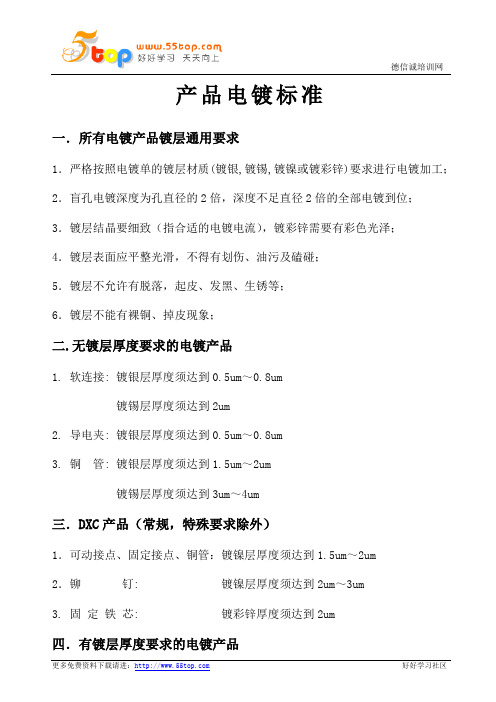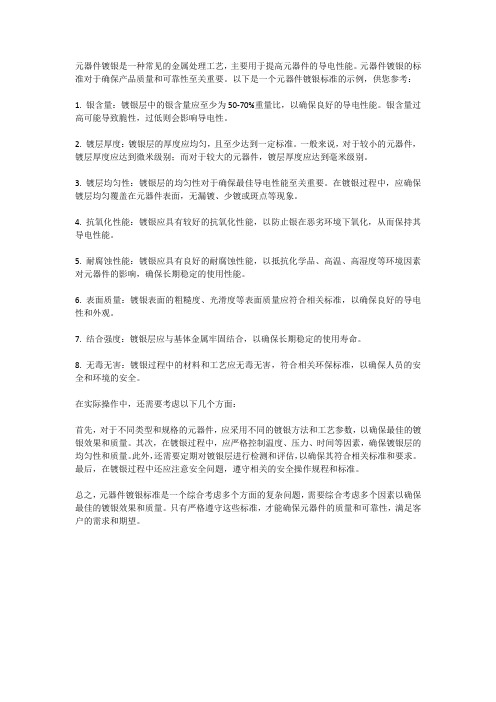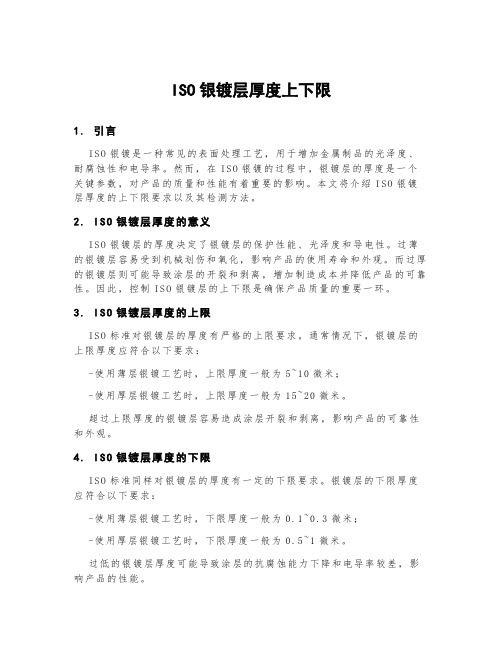关于镀银层厚度
关于镀银层厚度

关于镀银层厚度,我从贾工处了解了一些信息,集合资料,现总结如下:About the thickness of the silver coating, I get some information from our expert , following is the collection of the information.电镀性质决定镀层厚度不可能很均匀,边角处、折角处(国际上采用直径为19的球测量直径以外区域,国内用直径20的球测量直径以外区域)、深孔处等只需做到有镀层即可,不可能所有面、所有点都达到5μm以上,只能说主要面最小厚度尽量做到等于或者大于5μm,具体可参考相关电镀标准(国标或者ISO标准)。
Plating’s nature determines that the coating thickness woule not be very uniform. It is acceptable that there are coating at corners(international people measure other area with a ball of diameter 19 while domestic people measure it with a ball of diameter 20) and deep holes. Coating thichness at all faces, points will not be all thicker than 5 μ m. We can only say that we will try our best to achieve that the minimum coating thickness at major surfaces is equal to or greater than 5 μm. And you can refer to related electroplating standard (domestic standard or ISO standard) for details.1、镀层均匀性:thickness uniformity所有电镀层的厚度都不会是均匀的,这是电镀的性质决定的。
金属覆盖层银和银合金电镀层试验方法第一部分镀层厚度的测定

金属覆盖层银和银合金电镀层试验方法第一部分镀层厚
度的测定
镀层厚度的测定是金属覆盖层研究中的重要部分,本文通过对银和银合金电镀层试验方法的探讨,介绍了几种常用的测量手段。
常用的测量手段包括光学显微镜法、电子显微镜法、扫描探针显微镜法、剥离法和X射线荧光分析法等。
光学显微镜法是一种定性和半定量的测量方法,通过观察镀层表面的放大图片来判断镀层的厚度。
由于观察角度和放大倍数的不同,这种方法通常只能提供一个相对的厚度值。
电子显微镜法是一种高分辨率的测量方法,通过扫描电子显微镜观察镀层表面的形貌,并通过图像处理技术获得更准确的厚度测量结果。
这种方法可以提供较高的精确度和可靠性。
扫描探针显微镜法是一种在原子尺度下进行表面形貌和成分分析的方法。
通过扫描探针显微镜的探针与样品表面的相互作用,可以确定镀层的形貌和厚度,并通过能谱分析技术得到成分的信息。
剥离法是一种间接的测量方法,通过将镀层从基材上剥离并测量剥离后的镀层质量来确定厚度。
不同的剥离方法包括化学剥离法、机械剥离法和高压水剥离法等。
X射线荧光分析法是一种常用的物理测量方法,通过测量入射X射线与金属覆盖层发生的荧光射线的能量来确定镀层的成分和厚度。
这种方法具有快速、准确和非破坏性等特点。
在实际应用中,一般会综合运用以上几种方法进行测量,以提高测量结果的精确度和可靠性。
同时需要注意控制测量条件,比如温度、湿度和样品的准备等因素,以避免测量误差的产生。
总之,镀层厚度的测定是金属覆盖层研究中的重要环节,通过选择合适的测量手段和控制测量条件,可以得到准确可靠的测量结果,为金属覆盖层的应用提供有效的支持。
电镀技术标准

德信诚培训网
产品电镀标准
一.所有电镀产品镀层通用要求
1.严格按照电镀单的镀层材质(镀银,镀锡,镀镍或镀彩锌)要求进行电镀加工;2.盲孔电镀深度为孔直径的2倍,深度不足直径2倍的全部电镀到位;
3.镀层结晶要细致(指合适的电镀电流),镀彩锌需要有彩色光泽;
4.镀层表面应平整光滑,不得有划伤、油污及磕碰;
5.镀层不允许有脱落,起皮、发黑、生锈等;
6.镀层不能有裸铜、掉皮现象;
二.无镀层厚度要求的电镀产品
1. 软连接: 镀银层厚度须达到0.5um~0.8um
镀锡层厚度须达到2um
2. 导电夹: 镀银层厚度须达到0.5um~0.8um
3. 铜管: 镀银层厚度须达到1.5um~2um
镀锡层厚度须达到3um~4um
三.DXC产品(常规,特殊要求除外)
1.可动接点、固定接点、铜管:镀镍层厚度须达到1.5um~2um
2.铆钉: 镀镍层厚度须达到2um~3um
3. 固定铁芯: 镀彩锌厚度须达到2um
四.有镀层厚度要求的电镀产品
更多免费资料下载请进:好好学习社区。
元器件镀银标准

元器件镀银是一种常见的金属处理工艺,主要用于提高元器件的导电性能。
元器件镀银的标准对于确保产品质量和可靠性至关重要。
以下是一个元器件镀银标准的示例,供您参考:1. 银含量:镀银层中的银含量应至少为50-70%重量比,以确保良好的导电性能。
银含量过高可能导致脆性,过低则会影响导电性。
2. 镀层厚度:镀银层的厚度应均匀,且至少达到一定标准。
一般来说,对于较小的元器件,镀层厚度应达到微米级别;而对于较大的元器件,镀层厚度应达到毫米级别。
3. 镀层均匀性:镀银层的均匀性对于确保最佳导电性能至关重要。
在镀银过程中,应确保镀层均匀覆盖在元器件表面,无漏镀、少镀或斑点等现象。
4. 抗氧化性能:镀银应具有较好的抗氧化性能,以防止银在恶劣环境下氧化,从而保持其导电性能。
5. 耐腐蚀性能:镀银应具有良好的耐腐蚀性能,以抵抗化学品、高温、高湿度等环境因素对元器件的影响,确保长期稳定的使用性能。
6. 表面质量:镀银表面的粗糙度、光滑度等表面质量应符合相关标准,以确保良好的导电性和外观。
7. 结合强度:镀银层应与基体金属牢固结合,以确保长期稳定的使用寿命。
8. 无毒无害:镀银过程中的材料和工艺应无毒无害,符合相关环保标准,以确保人员的安全和环境的安全。
在实际操作中,还需要考虑以下几个方面:首先,对于不同类型和规格的元器件,应采用不同的镀银方法和工艺参数,以确保最佳的镀银效果和质量。
其次,在镀银过程中,应严格控制温度、压力、时间等因素,确保镀银层的均匀性和质量。
此外,还需要定期对镀银层进行检测和评估,以确保其符合相关标准和要求。
最后,在镀银过程中还应注意安全问题,遵守相关的安全操作规程和标准。
总之,元器件镀银标准是一个综合考虑多个方面的复杂问题,需要综合考虑多个因素以确保最佳的镀银效果和质量。
只有严格遵守这些标准,才能确保元器件的质量和可靠性,满足客户的需求和期望。
电镀表面及通用检验要求

电镀表面及能用检验要求第3 页,共5 页更新日期:2022/9/2项目要求判定标准缺陷判定CR MAJ MIN漏镀产品表面不允许有镀层未镀上的情况电镀件A面或B面有漏底材现场、不可接受√电镀件A面或B面有相关镀层未镀上、不可接受√电镀件凹位或阴角位明显发黄,组装后又不能够遮盖的,不接受。
√电镀件内部出现发黄面积超过其所在面的1/3或在组装后基本可遮盖,不可接受。
√电镀件内部未镀的地方生锈,不能接受。
√电极点周围有未镀上痕迹,组装不能完全遮盖。
其外露面积不超过2.0mm2,40cm处观察不明显。
√4.2电镀层附着力测试1)划痕法(此法不适合于镀铬件、其余镀层可以)(1)测试工具\设备:百格刀、软刷子、3M透明胶带(宽度15mm)(2)测试方法:a)在镀层有面有百格刀在横向和竖向分别割10x10的格(间距1mm),每一条划线应深及基材;b)用软毛刷向格阵图形的两对角轻轻地向后扫刷5次,向前扫刷5次的测试样本表面。
c)将3M透明胶带纸粘贴在100格阵图表面,用橡皮擦在其上面来回磨擦,使其完全密贴。
d)用手接住胶带一端,以45度方向迅速撕开,观察镀层表面。
如目视无法观察清楚,可使用10倍显微镜观察。
(3)判断标淮:4B(在切口的相交处有小片剥落,面积≤5%)及以上为合格表2 百格试验判定标准ASTM等级ISO等级判定标准图例0B 5级脱落总面积大于65%1B 4级边缘大片剥落,或者一些方格或全部剥落,其面积大于划格区的35%,但不超过65%2B 3级边缘有部分剥落或者大片剥落,或部分格子整片剥落,其面积大于划格区的15%,但不小于35%3B 2级边缘或相交处有被剥落,其面积大于划格区的5%,但小于15%4B 1级边缘的相交处有小片剥落,划格区内的实际破损≤5%5B 0级边缘完全光滑,格子边缘没有任何剥落。
镀银标准中对银层厚度的规定

镀银标准中对银层厚度的规定电子产品中对电和波的传导最常用的镀层是镀银。
由于镀银是贵金属电镀,金属银和银盐的消耗是需要加以控制的指标.其中对镀层厚度的控制是一个重要的指标。
我国电子行业军用标准《电子设备的金属镀覆与化学处理》(SJ 20818--2002)对铜上镀银的厚度要求分为室内、室外两种,室内规定为8μm,室外规定为15μm。
对铝和铝合金上、塑料上的银镀层的厚度要求和铜基的一样,只是对底镀层的要求,根据不同的基体材料和所处的使用环境而有所不同。
这种要求与国际上对镀银厚度的规定是基本一致的。
在日本工业标准(JIS)H0411《镀银层检验方法》中,将镀层厚度分为七个等级,我们的规定相当于其中的第四类和第五类E3]。
镀银层厚度的分级参数见表。
镀银层厚度的分级参数①耐磨性试验采用落砂法,让40目左右的砂粒从管径为5mm 的漏斗落到以45°角放置的镀层试片上,露出底层为终点.落砂量为450g,落下距离为l000mm,测量所用的时间。
测量第l、2类镀层时,所用管径为4mm,落砂量为1l0g,落下距离为200mm。
美国对镀银层厚度的规定大致相当于以上分类中从第三类起到第七类,是以8μm为基准厚度,其他类与基准成倍数关系。
比它低一级的厚度为基准的0.5倍为4/μm,比基准商一级的是它的1倍,为16μm,再高一级是其2倍,为24μm,最高为3倍,32μm。
我国对镀银层厚度的规定根据原电子工业部早期标准是给出了一定的范围的,即室内或良好环境,银层厚为7~10μm,室外或不良环境为15一20μm。
同时,所有国家或地区的标准都允许在特别需要时还可以指定更厚的镀层。
从这些标准和我们了解到的实际情况来看,镀银的厚度每增加一个级别,其银的用量都是成倍增加的。
从理论上说,ltzm/dm2的银用量约为0.1g。
考虑到电镀过程中的工艺损耗,实际耗银量还要增加。
当受镀面积比较大、镀层厚度增加时,成本的增加是很明显的。
而微波器件中相当一部分的表面积是比较大的,因此,镀银层厚度的选择直接关系到产品的成本控制。
镀银一般要求

UNIVERSE 1.所有要鍍銀的錶殼、錶帶或其他零件須先電鍍一層鎳。
2.鍍銀層的厚度為5Microns,可容忍誤差±10%。
3.鍍銀後,要再鍍上一層薄薄的銠金屬,用以防止銀層氧化。
任何有機塗層或亮漆皆一概不能使用。
4.所有已電鍍表面皆不能出現褪色、污點、不均勻、水泡或小沙孔等現象。
5.合格測試程序:在正式生產前,必先呈交6塊已鍍銀樣本作測試,測試合格者方可開始生產。
a.人工汗測試將樣本浸入人工汗夜裏,保持在室溫情況下浸15分鐘,取出後要沒有變色或變暗才算合格。
b.膠貼測試將一片黏貼膠紙牢牢地貼在已鍍銀的表面上,然後把它撕去,表層的銀沒有被扯出才算合格。
c.磨損測試所有樣本必須通過磨損測試(請參考磨損測試規格說明),才算合格。
UNIVERSE 6.生產品質控制:在生產途中,要抽檢樣本測試,以確定其鍍銀質素達到所訂的規格要求,與合格樣本無異。
A. 將被抽檢樣本中的十分一在車間內即場作人工汗測試。
B.鍍銀層的厚度要隨機地抽樣量度。
【精品】镀银检验标准

附件 4 镀银、导电氧化检验标准1 目的为了规范京信公司铝合金、铜合金、钢材等结构件和电子元器件镀银、导电氧化的质量要求,对镀银和导电氧化的产品接收标准作出明确界定,作为检验和判定的依据。
2 适用范围本标准适用于京信无源产品中结构件的表面等类划分及其外观质量要求。
本标准适用于对无源结构件电镀验收及产品的装配生产。
3 总则3.1 原则:产品外观应美观,单独一零/部件的整体效果不能受到破坏,如果发现某一缺陷具有批量性问题,即便此缺陷属于“可接收”范围,也可以对该产品不予验收。
3.2 产品各部位表面按其在产品中所处位置和质量要求分类: A 级表面:图纸要求电镀面,为产品性能要求镀银的表面,如:双工器腔体内部、双工器腔体外面装配接头面,盖板(接触腔体内侧面)、滤波器内部、接头内芯等 B 级表面:即图纸要求的电镀面,但是非性能要求镀银面,如:腔体顶面、螺钉孔位。
C 级表面:即主要为非产品性能要求且非装配要求面,如:腔体减重面(见图中C 点)例如:DU-G2005-D01/D02 腔体3.3 凡是镀银层厚度在8μ 或8μ 以上的均默认为有交调要求,镀银层要求为亚银;如果图纸有要求镀亚银或者镀亮银,均以图纸为准。
3.4 本标准若与图纸、相关检查及客户检验规定发生冲突时,以上述规定和图纸为准;有封样或图纸上有特殊要求的零部件,其对应的缺陷优先按其封样或技术要求的标准进行判断,如果此判断严重影响到性能,按照最严格的标准进行重新判断(标准依据:国家标准、行业标准、图纸、封样、本标准);其它结构件表面缺陷的程度不能超出本标准的要求,否则为不合格。
3.5 每本标准所列的缺陷个数当在每一表面上超过2 个时, 2 个缺陷之间的距离必须大于10mm,否则视为同类缺陷,面积以其总和计。
3.6 凡是要求镀银的产品(包括亚银、亮银、半亚半亮银),要求烤贝纸密封包装,内含防潮珠(即要求对镀银层起到防潮防氧化的保护作用);要求能够在18~27℃,湿度为45~70%中存放3 个月不变色,外观良好。
铜表面镀银层厚度现场测量方法

铜表面镀银层厚度现场测量方法以铜表面镀银层厚度现场测量方法为题,本文将详细介绍一种用于测量铜表面镀银层厚度的现场测量方法。
铜表面镀银层是一种常见的表面处理技术,用于提高铜制品的抗氧化、耐腐蚀性能,提高外观质量。
然而,为了确保镀银层的质量,需要对其厚度进行准确测量。
以下是一种常用的现场测量方法。
一、仪器和设备准备1. 镀银层厚度测量仪:选择具有高精度的镀银层厚度测量仪,如X 射线荧光光谱仪(XRF)。
2. 校准样品:准备一系列已知厚度的镀银层校准样品,用于校准测量仪。
二、测量步骤1. 校准测量仪:使用校准样品对测量仪进行校准,确保测量结果准确可靠。
2. 准备待测样品:将待测的铜制品清洁干净,确保表面无杂质和污染。
3. 测量位置选择:根据需要测量的区域选择合适的位置进行测量,可以选择多个位置进行平均值计算。
4. 测量操作:将测量仪的探头对准待测位置,触发测量仪进行测量。
5. 多次测量:为了提高测量的准确性,可以对同一位置进行多次测量,并计算平均值。
6. 数据记录与分析:将测量结果记录下来,并根据需要进行数据分析和处理。
三、注意事项1. 保持仪器的稳定性:在测量过程中,要保持仪器的稳定性,避免外部干扰对测量结果产生影响。
2. 避免人为误差:操作人员应熟悉测量仪的使用方法,并按照操作规程进行操作,避免人为误差的产生。
3. 校准周期:校准样品的使用寿命有限,需要定期更换,以保证测量结果的准确性。
4. 安全注意:使用测量仪时,要注意安全事项,避免对人体和环境造成伤害。
四、优点和应用范围1. 高精度:X射线荧光光谱仪(XRF)具有高精度的测量能力,可以准确测量铜表面镀银层的厚度。
2. 非破坏性:该测量方法是非破坏性的,不会对待测铜制品造成损伤。
3. 实时性:测量过程简便快速,可以实时获取测量结果,提高工作效率。
4. 应用范围广:该测量方法适用于各种铜制品的镀银层厚度测量,如电子元器件、装饰品等。
总结:铜表面镀银层厚度的现场测量方法是一种重要的工艺控制手段,可以帮助生产厂商确保镀银层质量符合要求。
关于零部件镀层厚度的补充技术说明

关于零部件镀层厚度的补充技术说明
为进一步明确关于接触面镀银层厚度的要求,特作如下附加说明:静搭接面镀银厚度满足2um;动搭接面镀银厚度满足6um。
其中动搭接部件如下:
1.静触头:从静触头的非固定面前端沿圆柱外表面40mm以内部分。
(如图一)
2.鸭嘴触头:与母排搭接滑动表面部分(如图二)
3.梅花触头:与静触头接触滑动表面、触臂接触滑动表面。
(如图三)
4.触臂:触臂前端与梅花触头滑动搭接外圆柱表面。
(如图四)
5.与鸭嘴触头配合搭接母线:母线前端沿外表面40mm以内表面。
(如图五)
6.除以上规定的部位以外,其余部位可视为静搭接。
注:(!)在招标报价时,将图纸中技术要求与本附加要求进行结合报价!与图纸冲突部分以本技术要求为准!
(2)另外单独对梅花触头进行整体镀银6um的报价!
山东泰开电器开关有限公司共1页第1页。
铜排镀银厚度标准__概述说明以及解释

铜排镀银厚度标准概述说明以及解释1. 引言1.1 概述铜排镀银是一种常见的电子元件制造过程,它在电子工业中具有广泛的应用。
在该过程中,铜表面经过化学腐蚀后被涂上一层均匀且致密的银层,以提供更好的导电性和抗氧化性能。
1.2 文章结构本文旨在全面介绍铜排镀银厚度标准的定义、意义、制定过程及其应用范围。
文章分为五个主要部分:引言、铜排镀银厚度标准、标准的概述说明、标准的解释与理解、结论。
1.3 目的本文旨在帮助读者更好地理解和运用相关标准,从而确保生产出符合要求和可靠性高的产品。
通过详细解释和说明铜排镀银厚度标准,读者将能够了解到标准对于产品质量控制及工程实践中的重要意义。
此外,文章还将提供对当前标准存在差异和改进方向的讨论,以促进行业发展并指导未来研究方向。
这样写可以吗?2. 铜排镀银厚度标准:2.1 铜排镀银的背景和重要性:在电子工业中,铜排镀银是一种常见的技术。
它可以改善铜导电材料的导电性能,增强抗氧化能力并提高耐腐蚀性。
由于这些优点,铜排镀银被广泛应用于各种电子设备和器件中,包括PCB(Printed Circuit Board)电路板、集成电路封装、连接器等。
因此,确保铜排镀银层的厚度符合标准非常关键。
2.2 铜排镀银厚度的定义与意义:铜排镀银厚度是指将一定面积的银沉积在铜表面形成的层厚度。
它通常以微米(μm)为单位表示。
具体而言,这个指标用来衡量产品中使用的银数量以及其在实际应用中扮演的作用。
适当的厚度可以确保良好的导电性能和抗腐蚀性能,并且对于信号传输和产品可靠性也有重要影响。
2.3 目前存在的铜排镀银厚度标准及其差异:目前,针对铜排镀银厚度的标准主要由国际标准化组织(ISO)和行业协会制定。
这些标准通常包含了在不同应用领域中所需的最低和最高铜排镀银厚度。
然而,由于不同行业对产品要求的差异以及技术和设备的限制,不同的标准可能存在一定的差异。
因此,根据具体应用需要选择合适的标准并进行相应调整至关重要。
iso银镀层厚度上下限

ISO银镀层厚度上下限1.引言I S O银镀是一种常见的表面处理工艺,用于增加金属制品的光泽度、耐腐蚀性和电导率。
然而,在IS O银镀的过程中,银镀层的厚度是一个关键参数,对产品的质量和性能有着重要的影响。
本文将介绍I SO银镀层厚度的上下限要求以及其检测方法。
2. IS O银镀层厚度的意义I S O银镀层的厚度决定了银镀层的保护性能、光泽度和导电性。
过薄的银镀层容易受到机械划伤和氧化,影响产品的使用寿命和外观。
而过厚的银镀层则可能导致涂层的开裂和剥离,增加制造成本并降低产品的可靠性。
因此,控制I SO银镀层的上下限是确保产品质量的重要一环。
3. IS O银镀层厚度的上限I S O标准对银镀层的厚度有严格的上限要求。
通常情况下,银镀层的上限厚度应符合以下要求:-使用薄层银镀工艺时,上限厚度一般为5~10微米;-使用厚层银镀工艺时,上限厚度一般为15~20微米。
超过上限厚度的银镀层容易造成涂层开裂和剥离,影响产品的可靠性和外观。
4. IS O银镀层厚度的下限I S O标准同样对银镀层的厚度有一定的下限要求。
银镀层的下限厚度应符合以下要求:-使用薄层银镀工艺时,下限厚度一般为0.1~0.3微米;-使用厚层银镀工艺时,下限厚度一般为0.5~1微米。
过低的银镀层厚度可能导致涂层的抗腐蚀能力下降和电导率较差,影响产品的性能。
5. IS O银镀层厚度的检测方法为了确保IS O银镀层的厚度符合要求,可以使用以下常见的检测方法:-电子显微镜(S EM):通过扫描电子显微镜观察银镀层的形貌来检测其厚度。
-X射线荧光光谱(XR F):利用X射线荧光光谱仪测量银镀层中银元素的含量来推算出厚度。
-晶垂直切割法:将样品切割成薄片,然后使用显微镜观察银镀层和基材之间的界面,推算出厚度。
这些方法可以准确地检测IS O银镀层的厚度,确保产品质量符合标准要求。
6.结论I S O银镀层的厚度是确保产品质量的重要参数,过高或过低的银镀层厚度都会影响产品的使用寿命和性能。
铜表面镀银层厚度现场测量方法

铜表面镀银层厚度现场测量方法以铜表面镀银层厚度现场测量方法为标题,本文将介绍一种常用的测量铜表面镀银层厚度的方法。
一、背景铜表面镀银层是一种常见的表面处理方式,可提高铜材料的耐腐蚀性能和外观质量。
然而,镀银层的厚度是影响其性能的关键因素,因此需要对其进行精确测量。
二、仪器与设备1. 电子显微镜:用于观察镀银层的形貌和厚度。
2. 电子天平:用于测量铜材料的质量。
3. 镀银层厚度测量仪:用于直接测量镀银层的厚度。
4. 扫描电子显微镜:可用于观察镀银层的形貌和厚度。
三、测量方法1. 样品准备:将待测铜样品切割成合适的尺寸,并进行表面清洁,确保无杂质干扰。
2. 电子显微镜观测:使用电子显微镜观测铜样品的表面形貌,并选取适当位置进行测量。
3. 电子天平测量:使用电子天平测量铜样品的质量,得到准确的铜材料质量值。
4. 镀银层厚度测量仪测量:将铜样品放置在镀银层厚度测量仪上,仪器将自动测量并显示镀银层的厚度。
5. 扫描电子显微镜观测:使用扫描电子显微镜观测镀银层的形貌和厚度,并与前面的测量结果进行对比,以验证测量的准确性。
四、注意事项1. 在进行测量之前,要确保仪器和设备的准确性和可靠性。
2. 在进行测量时,要注意避免样品的污染和损坏。
3. 测量过程中,要确保样品与仪器接触良好,以保证测量结果的准确性。
4. 针对不同厚度的镀银层,可以选择不同的测量方法和仪器,以获得更精确的测量结果。
5. 镀银层厚度的测量结果应进行多次测量并取平均值,以减小误差。
五、总结本文介绍了一种常用的测量铜表面镀银层厚度的方法。
通过使用电子显微镜、电子天平和镀银层厚度测量仪等仪器设备,可以准确地测量铜表面镀银层的厚度。
在实际应用中,可以根据需要选择不同的测量方法和仪器,以满足不同材料和厚度的测量要求。
金属覆盖层铜镀银厚度测试方法分析

62作者简介:张业真(1987— ),男,工程师,学士,从事低压电器检测工作。
张业真,朱翔,徐名中(福建省产品质量检验研究院,福建 福州 350002)摘 要:对标准GB/T 16921—2005与国家电网有限公司[2018]979号文件中对金属覆盖层镀银厚度试验要求与规定进行研究,提出在进行金属覆盖层铜镀银测试过程中,会因产品测试点不同部位、不同面、不同角度的变化,对铜镀银层厚度数值出现不一样的结果,对调整测试仪器中的测量距离是否会改变铜镀银层厚度数值进行了分析研究,并给出了在测试金属覆盖层铜镀银产品时应当注意的事项与测试方法。
关键词:铜镀银层;部位;角度;测量距离中图分类号:TM591 文献标识码:B 文章编号:1007-3175(2021)03-0062-04Abstract: According to the standard GB/T 16921—2005 and State Grid Co., Ltd. [2018] No. 979, the test requirements and regulations of the silver plating thickness of the metal coating are studied. It is proposed that in the process of testing the copper silver plating of the metal covering layer, different results will appear on the thickness of the copper silver plating layer due to the changes in different parts, different sides and different angles of the product test points, and to analyze and study whether adjusting the measuring distance in the test instrument will change the thickness of the copper silver-plated layer, and give the matters and test methods that should be paid attention to when testing the copper silver-plated product with the metal covering layer.Key words: copper silver plating layer; part; angle; measuring distanceZHANG Ye-zhen, ZHU Xiang, XU Ming-zhong(Fujian Inspection and Research Institute for Product Quality, Fuzhou 350002, China )Analysis on the Test Method of Copper Silver PlatingThickness of Metal Cover金属覆盖层铜镀银厚度测试方法分析0 引言金属覆盖层中铜镀银常应用于开关柜中手车触头、主母线、铜排搭接面、隔离开关触头以及其他相关金属带电部件上。
五金件镀银厚度范围

五金件镀银厚度范围
五金件镀银,这可不是个小事情!镀银的厚度范围那可是有讲究的。
您想想,要是镀银太薄,那能起到啥好效果?就好比冬天穿了件薄
得像纸的棉袄,能保暖吗?根本挡不住风,也扛不住冷啊!镀银薄了,五金件就容易磨损、变色,这质量能过关吗?那使用寿命不得大打折扣?
可要是镀银太厚呢?是不是就一定好?嘿,这可不一定!就像一个
人穿了好几层厚棉袄,行动都不方便了!镀银太厚,成本得多高啊!
这得花多少冤枉钱?而且太厚了说不定还影响五金件的性能和灵活性呢!
那到底多厚合适呢?一般来说,常见的五金件镀银厚度在 0.1 微米
到 5 微米之间。
这就好比做菜放盐,得掌握好那个度,不多不少刚刚好。
比如说一些小型的精密五金件,像手表里的小零件,镀银厚度可能
就在 0.1 微米到 1 微米左右。
为啥呢?因为这些零件精细啊,稍微厚点可能就影响精度和灵活性啦!
再比如一些大型的五金件,像家具上的拉手,镀银厚度可能就在 2
微米到 5 微米之间。
这是为啥?因为它们使用频繁,接触的东西多,
镀银薄了容易磨损,厚点才能更耐用。
不过,这也不是绝对的。
还得看具体的使用环境和要求。
要是在潮湿、腐蚀性强的环境里,镀银就得厚点,不然很容易就被腐蚀掉了。
这就像在下雨天,您得穿厚点的雨衣,不然能不被淋湿吗?
总之,五金件镀银厚度范围可不是随便定的,得综合考虑各种因素。
咱得根据实际情况,选择最合适的镀银厚度,这样才能既保证质量,
又不浪费钱。
您说是不是这个理儿?。
导电片触头镀银层厚度

导电片触头镀银层厚度
导电片触头镀银层厚度决定了导电片的导电性能和耐腐蚀性能。
在各种电子设备中,导电片触头的质量直接影响了设备的使用寿命和性能稳定性。
因此,合理控制导电片触头镀银层厚度是至关重要的。
导电片触头镀银层的厚度应该根据具体的应用需求和材料性质来确定。
一般来说,导电片触头镀银层的厚度过薄会导致接触电阻增大,从而影响导电性能。
而过厚的银层则会增加成本,并且可能引起镀层的剥落或者产生应力集中的问题。
为了保证导电片触头镀银层的合理厚度,需要进行一系列的测试和优化。
首先,可以通过实验室的方法来测量导电片触头的电阻和电流,以评估镀银层的导电性能。
然后,根据实际使用环境和要求,结合材料的特性,确定合适的镀银层厚度。
在实际生产过程中,可以采用电化学方法进行导电片触头的镀银。
通过控制镀银液的成分、温度和电流密度等参数,可以实现对镀银层厚度的精确控制。
此外,还可以采用物理方法如蒸镀或喷涂等,来实现导电片触头的镀银。
需要注意的是,导电片触头镀银层厚度的控制不仅仅取决于技术手段和设备的条件,还需要考虑到经济效益和可行性。
在制定镀银工艺参数时,需要综合考虑成本、性能和可靠性等因素,以达到最佳的效果。
导电片触头镀银层厚度的合理控制对于提高导电片的导电性能和耐腐蚀性能至关重要。
通过实验和优化,结合材料特性和实际需求,可以确定合适的镀银层厚度,并采用适当的工艺方法来实现镀银。
这样可以保证导电片触头的质量和稳定性,提高电子设备的性能和可靠性。
导电片触头镀银层厚度

导电片触头镀银层厚度
导电片触头镀银层厚度是一项重要的技术指标,对于提高导电片的导电性能具有至关重要的作用。
本文将从导电片触头镀银层厚度的意义、影响因素以及实际应用等方面进行探讨。
导电片触头的镀银层厚度对导电性能具有重要的影响。
合适的镀银层厚度可以提高导电片的导电性能,从而确保电流的稳定传输。
镀银层相对于导电片来说具有较低的电阻率,可以有效地降低电阻,减少能量损耗。
因此,合理控制导电片触头的镀银层厚度,可以提高导电片的导电效率,保障电路的正常运行。
导电片触头镀银层厚度的选择需要考虑多个因素。
首先是导电片材料的特性,不同材料的导电片触头对镀银层厚度的要求也不同。
其次是导电片的工作环境,如温度、湿度等因素会对镀银层的稳定性产生影响。
此外,还需考虑到经济成本和生产工艺等方面的因素,以制定合理的镀银层厚度标准。
在实际应用中,导电片触头镀银层厚度的选择需要根据具体的需求来确定。
一般来说,对于要求较高的电路系统,需要选择相对较厚的镀银层,以确保导电性能的稳定性和可靠性。
而对于一些低要求的电路系统,则可以选择较薄的镀银层,以降低成本和减少能量损耗。
导电片触头镀银层厚度是影响导电性能的重要指标。
合适的镀银层
厚度可以提高导电片的导电性能,保障电路的正常运行。
在选择镀银层厚度时需要综合考虑导电片材料特性、工作环境、经济成本等多个因素,以制定合理的标准。
通过科学合理地选择镀银层厚度,可以提高导电片的导电效率,确保电路的稳定传输,进而提高电子设备的性能和可靠性。
- 1、下载文档前请自行甄别文档内容的完整性,平台不提供额外的编辑、内容补充、找答案等附加服务。
- 2、"仅部分预览"的文档,不可在线预览部分如存在完整性等问题,可反馈申请退款(可完整预览的文档不适用该条件!)。
- 3、如文档侵犯您的权益,请联系客服反馈,我们会尽快为您处理(人工客服工作时间:9:00-18:30)。
关于镀银层厚度,我从贾工处了解了一些信息,集合资料,现总结如下:About the thickness of the silver coating, I get some information from our expert , following is the collection of the information.电镀性质决定镀层厚度不可能很均匀,边角处、折角处(国际上采用直径为19的球测量直径以外区域,国内用直径20的球测量直径以外区域)、深孔处等只需做到有镀层即可,不可能所有面、所有点都达到5μm以上,只能说主要面最小厚度尽量做到等于或者大于5μm,具体可参考相关电镀标准(国标或者ISO标准)。
Plating’s nature determines that the coating thickness woule not be very uniform. It is acceptable that there are coating at corners(international people measure other area with a ball of diameter 19 while domestic people measure it with a ball of diameter 20) and deep holes. Coating thichness at all faces, points will not be all thicker than 5 μ m. We can only say that we will try our best to achieve that the minimum coating thickness at major surfaces is equal to or greater than 5 μm. And you can refer to related electroplating standard (domestic standard or ISO standard) for details.1、镀层均匀性:thickness uniformity所有电镀层的厚度都不会是均匀的,这是电镀的性质决定的。
因为在同一个制件上,电流密度不可能做到均匀。
The coating thickness of all plating will not be uniform, this is determined by the nature of the electroplating. Because in the same product, current density might not be uniform.不管什么电镀都是厚度不均匀,只是相差的大与小的问题,如挂镀时,每挂最上面和下面的工件肯定会比中间的厚一些,滚镀的有时一些工件滚到一些死角的地方,厚度比那些滚的流畅的工件厚度要薄一些,那单个工件来说,边角部分的厚度比中间部位的厚度要厚,这是肯定的,虽然有些厂里做了工件高区的遮挡,以免电流增大,高区烧焦,也是为了低区的厚度提升,高区厚度降低,来提升整体的厚度均匀,但是还是不可能那么均匀。
这所有这些现象都是一个原因,就是电镀产品电镀时的情况就像磁铁一样有一个磁力线原理,边角或尖端的电流线是密集的,中间肯定会比边缘的少的缘故。
No matter what kind of plating it is, the thickness will not be uniform. It is just the problem whether the difference is big or small. such as the huning plating,the top and bottom of every workpiece will be thick than middle,and in rolling plating, sometimes the thickness of some blind angle is thinner than fluent rolling workpiece. It is sure that for the individual workpiece, the thickness of edge is thicker than the middle place.Although some of the factories keep the high place of workpiece be covered to avoid being burned because of the bigger electric current and to improve the uniform of the plating by increasing the thickness of high place and decrease the thickness of low area, the whole thickness is still not so uiform. These phenomena is come from the same reason, that is, just like a magnet, the plating products also have a pricple of magbnetic field lines, the electric current line of corner and sharp corner is intensive, and the coating thickness in the middle must be less than the edge area.2、电镀工艺缺陷:Electroplating process defect工艺允许的缺陷是指由于电镀工艺的限制,在电镀加工过程中出现的不可克服的缺陷,在一定的范围内,不作为不合格的判定依据。
工艺允许的缺陷往往是由于镀件结构复杂和电镀工艺技术的限制而难以完全消除的缺陷,比如深孔内可以允许一定孔深内没有镀层,或规定孔口向内的一定距离内有镀层即为合格等。
但是工艺允许的缺陷以不损失产品的使用功能为前提,是在不影响产品性能前提下的让步接收。
Allowing process defect means that because of the limitation of plating processes some overcome defects appeare in the process, in a certain range, it would not be the judgement basis as an unqualified product. Allowing process defect is always the result from a complex structure of the plating and the limitation of electroplating process technical which is completely eliminate.For example, in a deep hole, it is allowed that there would be no coating in the certen deepness, or it would regulate that when there is coating from the orifice to the certen distance, it is a qulified product, etc.But the primise of the allowing process defect is that it cannot loss the using function of the product, it would be acceptable when there is no influence to the product.3、镀层测量 GB12334 等效 ISO 2064coating measurement GB12334 is equal to ISO 2064(1) 适用范围本国际标准定义了有关任何基体上的金属和其他非有机覆盖层厚度测量的术语。
此外,还规定了一些测量覆盖层最小厚度所要遵循的通则。
Applicable scope, this international standard defines the terms about any substrate of metal and other than organic layer thickness measurement.In addition,it also gives out general rules to measure the minimum thickness of the cover.(2) 本国际标准采用以下定义①主要表面:工件上已涂覆或待涂覆的部分,对这部分而言,覆盖层对使用性能和/或外观都是至关重要的;并且这部分的覆盖层必须符合所有规定要求。
②测量面:主要表面上作单个测量的区域。
以下方法的“测量面”的相应定义为:This international standard adopts the following definitions (1) : the major surface: as for the part of workpiece which has been coated or will be coated, it is very important to the use performance and/or appearance. And the cover on this part must comply with all requirements. (2) the measuring surface:the main surface is a single measuring area. Following are the correspondent definitions of “measuring surface” by different ways.(a)分析法的测量面为退除覆盖层的区域;Analysis: the measuring surface is the area where the cover is stripped.(b)阳极溶解法的测量面为电解池封闭圈所包围的区域;An anodic dissolution: the measuring surface is the area surrounded by electrolysis pool closed circle.(c)显微镜法的测量面为在规定放大倍数下的视野区域;Microscopy: the measuring urface is the view area that be enlarged under provide multiple.(d)无损法的测量面为探头区域或影响读数的区域。
